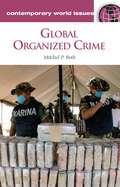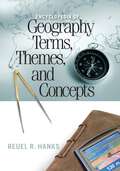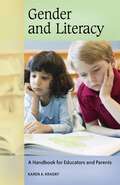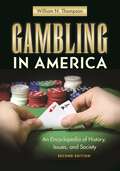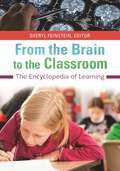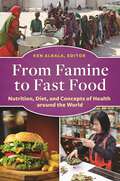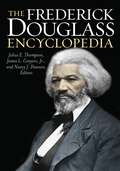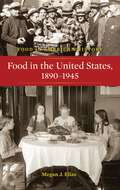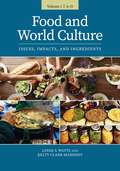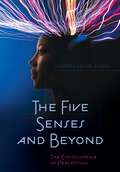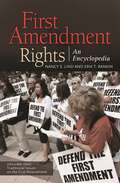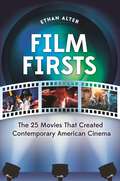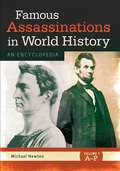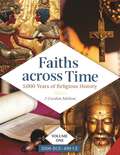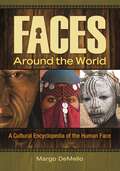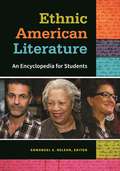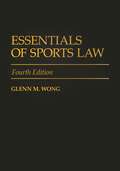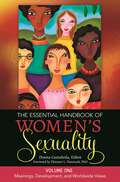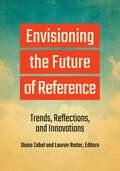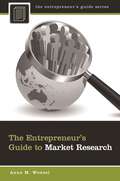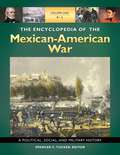- Table View
- List View
Global Organized Crime: A Reference Handbook (Contemporary World Issues)
by Mitchel P. RothThis book offers a comprehensive, multidimensional look into the major activities, groups, causes, and policing strategies related to global organized crime.Global Organized Crime: A Reference Handbook examines global organized crime dating back to its 17th-century roots. Unlike most works on the subject, which take a parochial approach by concentrating on individual countries or regions, this book uniquely details the impact of 21st-century globalization on such groups and their activities.Exploring the continuum of international organized crime and related developments from its early beginnings to the present era, the book also looks at the complicated issues that continue to influence its growth. It covers the impact of the end of the Cold War, immigration, the global drug trade, weapons sales, human smuggling and trafficking, the convergence of funding sources, and the effects of technology. What especially distinguishes this book is the connections it makes between organized crime activities and failed states, civil wars, political transitions, regional conflicts, and terrorist groups.
Encyclopedia of Geography Terms, Themes, and Concepts
by Reuel R. HanksThis text provides an essential reference handbook for students of geography and related social sciences.How did the Greek geographer Eratosthenes make an accurate calculation of the earth's circumstance more than 1,500 years before the first voyage of Columbus to the New World? What are the "green belts" of England that dominate its rural landscape? And what is regarded as the driest continent on the planet?This handbook offers a broad coverage of terminology and concepts, serving as both an encyclopedic dictionary of geography terms and an approachable overview to the human and physical aspects of world geography. Approximately 150 geographic terms and concepts are defined and discussed, providing an accessible reference for anyone who requires a deeper knowledge of the language and ideas that are important to geography as a discipline. Helpful sidebars are provided to shed light on unusual or controversial theories and concepts. All major geographic concepts and terms are addressed and comprehensively explained using examples.
Gender and Literacy: A Handbook for Educators and Parents (Handbooks for Educators and Parents)
by Karen A. KrasnyThis work offers parents, educators, and librarians a practical guide to discovering the ways gender identities are constructed through literacy practices, providing recommendations for addressing gender inequities in schools and in the community at large.Gender and Literacy: A Handbook for Educators and Parents focuses on issues related to the gendered experience of students from pre-kindergarten through grade 12, promoting an understanding that the issues surrounding gender cannot be reduced to broad generalizations. Author Karen A. Krasny seeks to make clear the complex notion of gender construction within the context of redefining what constitutes legitimate literacy practices in schools.This handbook will help to guide educators, parents, and librarians by assisting them in the selection and evaluation of print and media resources. The first chapter explains the need to understand the complex relationship between gender and literacy. The bulk of the book provides readers with a critical review of the studies conducted to investigate gendered literacy practices, while the last three chapters focus on actionable strategies and policy making.
Gambling in America: An Encyclopedia of History, Issues, and Society
by William N. ThompsonThis one-volume reference provides a comprehensive overview of gambling in the Americas, examining the history, morality, market growth, and economics of the gaming industry.This is the most complete encyclopedia of gambling, covering the industry in great detail including the players, the games, the venues, and the surrounding social issues. Updates in this second edition reveal the impact of technological advances on the games, the growing legislation regulating the industry, and the expanding global footprint of gambling across the world—from Manitoba to Montana.Author William N. Thompson postulates on the impact of gambling on local communities and shows how the U.S. gaming industry is tied to the global market, most notably gaming expansion in Macau and Singapore. The book addresses the various forms of gaming, such as casino-based and online gambling, sports betting, and lotteries. Additional content examines the social issue of problem and pathological gambling and addresses the rehabilitation programs available for the mitigation and treatment of gambling problems.
From the Brain to the Classroom: The Encyclopedia of Learning
by Sheryl FeinsteinSupplying a foundation for understanding the development of the brain and the learning process, this text examines the physical and environmental factors that influence how we acquire and retain information throughout our lives. The book also lays out practical strategies that educators can take directly into the classroom.Comprising more than 100 entries, From the Brain to the Classroom: The Encyclopedia of Learning gathers experts in the fields of education, neuroscience, and psychology to examine how specific areas of the brain work in thought processes, and identifies how educators can apply what neuroscience has discovered to refine their teaching and instructional techniques. The wide range of subjects—organized within the main categories of student characteristics, classroom instructional topics, and learning challenges—include at-risk behaviors; cognitive neuroscience; autism; the lifespan of the brain, from prenatal brain development to the aging brain; technology-based learning tools; and addiction. Any reader who is interested in learning about how the brain works and how it relates to everyday life will find this work fascinating, while educators will find this book particularly helpful in validating or improving their teaching methods to increase academic achievement.
From Famine to Fast Food: Nutrition, Diet, and Concepts of Health around the World
by Ken Albala Julia Abramson M. Shahrim Al-Karim E. N. Anderson Laura P. Appell-Warren Heather Arndt-Anderson Michael Ashkenazi Babette Audant Gabriela Villagran Backman Carolyn Bánfalvi Peter Barrett Cynthia D. Bertelsen Megan K. Blake Andrea Broomfield Cynthia Clampitt Neil L. Coletta Paul Crask Christine Crawford-Oppenheimer Anita Verna Liza Debevec Jonathan Deutsch Deborah Duchon Nathalie Dupree Pamela Elder Rachel Finn Richard Foss Nancy G. Freeman Ramin Ganeshram Hanna Garth Mary Gee Che Ann Abdul Ghani Maja Godina-Golija Annie Goldberg Darra Goldstein Keiko Goto Carla Guerrón Montero Mary Gunderson Liora Gvion Cherie Y. Hamilton Jessica B. Harris Melanie Haupt Ursula Heinzelmann Jennifer Hostetter Kelila Jaffe Zilkia Janer Brelyn Johnson Kate Johnston Desiree Koh Bruce Kraig R. J. Krajewski Erin Laverty Robert A. Leonard Jane Levi Yrsa Lindqvist William G. Lockwood Yvonne R. Lockwood Janet Long-Solís Kristina Lupp Máirtín Mac Con Iomaire Glenn R. Mack Andrea Macrae Giorgos Maltezakis Bertie Mandelblatt Marty Martindale Laura Mason Anton Masterovoy Anne Engammare Mcbride Michael R. Mcdonald Naomi M. Mcpherson Katrina Meynink Barbara J. Michael Diana Mincyte Rebecca Moore Nawal Nasrallah Henry Notaker Kelly O’ Leary Fabio Parasecoli Susan Ji-Young Park Rosemary Parkinson Charles Perry Irina Petrosian Suzanne Piscopo Theresa Preston-Werner Meg Ragland Carol Selva Rajah Birgit Ricquier Amy Riolo Owen Roberts Fiona Ross Signe Rousseau Kathleen Ryan Helen Saberi Cari Sánchez Peter Scholliers Colleen Taylor Roger Serunyigo Dorette Snover Celia Sorhaindo Lyra Spang Lois Stanford Aliza Stark Maria "Ging" Gutierrez Steinberg Anita Stewart Emily Stone Asele Surina Aylin Öney Tan Nicole Tarulevicz Karen Lau Taylor Thy Tran Leena Trivedi-Grenier Karin Vaneker Penny Van Esterik Richard Wilk Chelsie Yount Marcia ZoladzThe foods eaten by a nation's population play a key role in shaping the health of that society. This book presents country-specific information on how diet, food security, and concepts of health critically impact the well-being of the world's population.A country's food culture and eating habits directly impact the health and well-being of its citizens. Economic factors contribute to problems such as obesity and malnourishment. This book examines how diet affects health in countries around the world, discussing how the availability of food and the types of foods eaten influence numerous health factors and are tied to the prevalence of "lifestyle" diseases. Readers will discover the importance of diet and food culture in determining human health as well as make connections and notice larger trends within multicultural, international contexts.An ideal aid for high school and college students in completing research and writing assignments, this book supplies detailed diet- and health-related information about most major countries and regions in a single source. Each country profile will also include a convenient fact box with statistical information such as life expectancy, average caloric intake, and other health indicators.
The Frederick Douglass Encyclopedia
by Julius E. Thompson, James L. Conyers, Jr., and Nancy J. DawsonA new cornerstone reference for students, scholars, and general readers, on Frederick Douglass—his life, writings, speeches, political views, and legacy.Like no other reference before it, The Frederick Douglass Encyclopedia celebrates and investigates the life, writings, and activism of one of the most influential African Americans in U.S. history.The Frederick Douglass Encyclopedia offers more than 100 alphabetically organized entries covering Douglass's extraordinary journey from childhood in bondage to forceful spokesperson for equality and freedom before, during, and after the Civil War. In addition to biographical details, the book looks at the full breadth of Douglass's writings and speeches, as well as the events that shaped his intellect and political views. Together, these entries create an enduring portrait of one of the nation's most iconic figures, a man who went from slavery to invited guest in Abraham Lincoln's White House, whose commitment to freedom for all led to his participation in the first women's rights conference at Seneca Falls, and whose profound influence ranged well beyond the borders of the United States.
Food in the United States, 1890-1945 (Food in American History)
by Megan J. EliasNo American history or food collection is complete without this lively insight into the radical changes in daily life from the Gilded Age to World War II, as reflected in foodways.From the Gilded Age to the end of World War II, what, where, when, and how Americans ate all changed radically. Migration to urban areas took people away from their personal connection to food sources. Immigration, primarily from Europe, and political influence of the Caribbean, Latin America, and the Pacific brought us new ingredients, cuisines, and foodways. Technological breakthroughs engendered the widespread availability of refrigeration, as well as faster cooking times. The invention of the automobile augured the introduction of "road food," and the growth of commercial transportation meant that a wider assortment of foods was available year round. Major food crises occurred during the Depression and two world wars. Food in the United States, 1890-1945 documents these changes, taking students and general readers through the period to explain what our foodways say about our society. This intriguing narrative is enlivened with numerous period anecdotes that bring America history alive through food history.
Food and World Culture [2 volumes]: Issues, Impacts, and Ingredients [2 volumes]
by Linda S. Watts Kelty Clark-MahoneyThis book uses food as a lens through which to explore important matters of society and culture. In exploring why and how people eat around the globe, the text focuses on issues of health, conflict, struggle, contest, inequality, and power.Whether because of its necessity, pleasure, or ubiquity, the world of food (and its lore) proves endlessly fascinating to most people. The story of food is a narrative filled with both human striving and human suffering. However, many of today's diners are only dimly aware of the human price exacted for that comforting distance from the lived-world realities of food justice struggles. With attention to food issues ranging from local farming practices to global supply chains, this book examines how food&’s history and geography remain inextricably linked to sociopolitical experiences of trauma connected with globalization, such as colonization, conquest, enslavement, and oppression.The main text is structured alphabetically around a set of 70 ingredients, from almonds to yeast. Each ingredient's story is accompanied by recipes. Along with the food profiles, the encyclopedia features sidebars. These are short discussions of topics of interest related to food, including automats, diners, victory gardens, and food at world&’s fairs. This project also brings a social justice perspective to its content—weighing debates concerning food access, equity, insecurity, and politics.
The Five Senses and Beyond: The Encyclopedia of Perception
by Jennifer L. Hellier, EditorHow do our human senses work and help us interact with our surroundings, and what happens when these senses malfunction or are impaired? This book provides in-depth information that answers these questions and more.The Five Senses and Beyond: The Encyclopedia of Perception supplies students and general readers with accurate, up-to-date information about the human senses. It explains the "big five" senses in detail as well as lesser-known but important senses—perceptions such as balance, kinesthesia, temperature, and pain. After a helpful introduction, this reference work provides A-to-Z, cross-referenced entries on hundreds of topics in the realm of human perception that allow students to find and digest information quickly and draw connections between related topics. Through the use of activity sidebars, readers will also be able to explore the workings of the senses firsthand, lending an element of interactivity to this accessible encyclopedia. A convenient end-of-volume glossary provides definitions of unfamiliar terms.
First Amendment Rights [2 volumes]: An Encyclopedia [2 volumes]
by Nancy S. Lind Erik T. RankinThis two-volume work addresses every key, cutting-edge issue regarding the First Amendment, including subjects such as freedom of religion, freedom of press, freedom of speech, and freedom of organization. First Amendment Rights: An Encyclopedia provides both historical information and current, 21st-century topics in First Amendment issues. Volume 1 addresses the subject through the lens of past decisions and precedent, updated to include controversies between new social media and civil liberties. Volume 2 examines the current state of First Amendment rights, addressing the changes in interpretations of the First Amendment by the Roberts Court as well as in-vogue issues such as Occupy Movements as well as student rights and responsibilities in freedom of religion and speech cases. Key cases are highlighted throughout the text to further comprehension of the underlying issues and subtle complexities.The information is presented so that readers can examine cases in the Roberts court and draw their own conclusions. Coverage is also provided of the challenges and opportunities that arise with the adoption of new technologies and their impact on the interpretations of the First Amendment.
Film Firsts: The 25 Movies That Created Contemporary American Cinema
by Ethan AlterThis forward-looking exploration of contemporary American film across the last 40 years identifies and examines the specific movies that changed the film industry and shaped its present and future.Since the mid-1970s, American cinema has gone through enormous changes, such as the birth of the modern summer blockbuster, the rise of the independent film industry, ongoing technological advancements in special effects, and the ever-evolving models for film distribution. Written by a professional film critic and film buff, this book tells the story of contemporary American cinema in a unique and engaging way: by examining 25 key movies that demonstrated a significant creative, technological, or business innovation that impacted the industry at large.Each chapter in this chronological survey of contemporary film is divided into two sections: "The Film," which offers a critical overview of the film in question; and "The First," which describes the specific innovation achieved by that film and places that achievement in the larger historical context. Two additional appendices in each chapter explore other significant aspects of both the film and its groundbreaking nature. The broad coverage—ranging from action movies to horror films to science fiction favorites—ensures the work's appeal to all film fans.
Famous Assassinations in World History [2 volumes]: An Encyclopedia [2 volumes]
by Michael NewtonRepresenting a unique reference tool for readers interested in history, criminology, or terrorism, this book provides the most complete and up-to-date coverage of assassinations of key figures throughout history and around the world.Effecting the death of a political figure, a leader of a nation, or a public figure usually captures people's attention. But how often is assassination effective to achieve the larger objective beyond the death of the targeted individual? Famous Assassinations in World History: An Encyclopedia offers more than 200 entries on assassinations of all kinds that will allow readers to grasp the often-complex motivating factors behind each event and better understand historical and contemporary social unrest.Each entry identifies the assassination target and summarizes that person's significance; discusses the person's assassination, including the factors that led up to it and its political and cultural contexts; and explains the powerful effects of the assassination in world history. The encyclopedia also includes various sidebars that spotlight relevant individuals, groups, and movements and present intriguing factoids such as the final disposition of notorious assassins' weapons and various films and novels that were inspired by famous assassinations. In addition, 23 primary source documents provide accounts of assassinations throughout world history.
Faiths across Time [4 volumes]: 5,000 Years of Religious History [4 volumes]
by J. Gordon MeltonThis monumental, four-volume reference overviews significant events and developments in religious history over the course of more than five millennia.Written for high school students, undergraduates, and general readers interested in the history of world religions, this massive reference chronicles developments in religious history from 3500 BCE through the 21st century. The set comprises four volumes, treating the ancient world from 3500 BCE through 499 CE, 500 through 1399, 1400 through 1849, and 1850 through 2009. Each volume includes hundreds of brief entries, arranged chronologically and then further organized by region and religion. The entries provide fundamental information on topics ranging from the neolithic Ggantija temples near Malta through the election of Mary Douglas Glasspool as bishop of the Episcopal Diocese of Los Angeles in 2009. Global in scope and encyclopedic in breadth, this chronology of world religions is an essential purchase for all libraries concerned with the development of human civilization.
Faces around the World: A Cultural Encyclopedia of the Human Face
by Margo DeMelloThis book provides a comprehensive examination of the human face, providing fascinating information from biological, cultural, and social perspectives.Our faces identify who we are—not only what we look like and what ethnicities we belong to, but they can also identify what religions we practice and what personal ideologies we have. This one-of-a-kind A–Z reference explores the ways we change, beautify, and adorn our faces to create our personalities and identities.In addition to covering the basics such as the anatomical structure and function of parts of the human face, the entries examine how the face is viewed around the world, allowing students to easily draw connections and differences between various cultures around the world. Readers will learn about a wide variety of topics, including identity in different cultures; religious beliefs; folklore; extreme beautification; the "evil eye;" scarification; facial piercing and facial tattooing masks; social views about beauty including cosmetic surgery and makeup; how gender, class and sexuality play a role in our understanding of the face; and skin, eye, mouth, nose, and ear diseases and disorders. This encyclopedia is ideal for high school and undergraduate students studying anthropology, anatomy, gender, religion, and world cultures.
Ethnic Groups of the Americas: An Encyclopedia (Ethnic Groups of the World)
by James B. MinahanIntended to help students explore ethnic identity—one of the most important issues of the 21st century—this concise, one-stop reference presents rigorously researched content on the national groups and ethnicities of North America, Central America, South America, and the Caribbean.Combining up-to-date information with extensive historical and cultural background, the encyclopedia covers approximately 150 groups arranged alphabetically. Each engaging entry offers a short introduction detailing names, population estimates, language, and religion. This is followed by a history of the group through the turn of the 19th century, with background on societal organization and culture and expanded information on language and religious beliefs. The last section of each entry discusses the group in the 19th, 20th, and 21st centuries, including information on its present situation.Readers will also learn about demographic trends and major population centers, parallels with other groups, typical ways of life, and relations with neighbors. Major events and notable challenges are documented, as are key figures who played a significant political or cultural role in the group's history. Each entry also provides a list for further reading and research.
Ethnic Groups of South Asia and the Pacific: An Encyclopedia (Ethnic Groups of the World)
by James B. MinahanThis comprehensive guide to the Pacific and South Asia provides detailed and enlightening information about the many ethnic groups of this increasingly important region of the world.Ideally suited for high school and undergraduate students studying subjects such as anthropology, geography, and social studies, Ethnic Groups of South Asia and the Pacific: An Encyclopedia provides clear, detailed, and up-to-date information on each major group in South Asian and Pacific Island countries, including India, Nepal, Indonesia, Pakistan, Singapore, Australia, Tonga, Samoa, and the Solomon Islands. Organized alphabetically by ethnic group, each entry provides an introduction followed by accessible descriptions of the origins, early history, cultural life, political life, and modern history of the ethnicity. Alternate names, major population centers, primary languages and religions, and other important characteristics of each group are also covered. Beyond being a valuable resource for student research, this book will be enlightening and entertaining for general readers interested in South Asia and the Pacific.
Ethnic Groups of Europe: An Encyclopedia (Ethnic Groups of the World)
by Jeffrey E. ColeThis comprehensive survey of ethnic groups of Europe reveals the dynamic process of ethnic identity and the relationship of ethnic groups to modern states.Part of a five-volume series on ethnic groups around the world, Ethnic Groups of Europe: An Encyclopedia provides detailed descriptions of more than 100 European ethnic and national groups. Each entry provides an overview of the group as well as in-depth information on the group's origins and early history, cultural life, and recent developments. Among the information presented for each group are global and national population figures and accounts of geographical distribution, diaspora populations, the group's historic homeland, predominant religions and languages, and related groups. The entries also highlight places, people, and events of particular importance to each group, and sidebars introduce related topics of interest.Throughout the text, special attention is focused on the relationship between ethnicity and nationalism. An explanation of the methodology used for selecting the ethnic groups in the encyclopedia is also provided, as is an introductory essay on the topic of ethnicity in Europe.
Ethnic Groups of Africa and the Middle East: An Encyclopedia (Ethnic Groups of the World)
by John A. ShoupThis encyclopedia is an essential guide to the different ethno-linguistic groups in Africa and today's complicated Middle East region.Ethnic Groups of Africa and the Middle East contains encyclopedic entries arranged alphabetically within ethno-linguistic classifications. Each entry has four main sections: an introduction identifying the language group, where they are found, and their numbers; a brief discussion of their origins and early history; a section on cultural life that includes religion, literature, social organization, and art; and a final section on political organization and recent history. The contents are appropriate for high school and undergraduate students as well as for experts who need a refresher on groups in Africa and the Middle East. While certain ethnic groups have been combined into a single entry, some—such as the Tuareg, who are a Berber people—are described within their own entries because of their importance in history or cultural domination.
Ethnic American Literature: An Encyclopedia for Students
by Emmanuel S. NelsonUnlike any other book of its kind, this volume celebrates published works from a broad range of American ethnic groups not often featured in the typical canon of literature.This culturally rich encyclopedia contains 160 alphabetically arranged entries on African American, Asian American, Latino/a, and Native American literary traditions, among others. The book introduces the uniquely American mosaic of multicultural literature by chronicling the achievements of American writers of non-European descent and highlighting the ethnic diversity of works from the colonial era to the present. The work features engaging topics like the civil rights movement, bilingualism, assimilation, and border narratives. Entries provide historical overviews of literary periods along with profiles of major authors and great works, including Toni Morrison, Maxine Hong Kingston, Maya Angelou, Sherman Alexie, A Raisin in the Sun, American Born Chinese, and The House on Mango Street. The book also provides concise overviews of genres not often featured in textbooks, like the Chinese American novel, African American young adult literature, Mexican American autobiography, and Cuban American poetry.
Essentials of Sports Law: Fourth Edition
by Glenn M. WongIn this thoroughly revised Fourth Edition, Glenn Wong provides a comprehensive review of the various sports law issues facing professional, intercollegiate, Olympic, high school, youth, and adult recreational sports. Major topics include tort liability, contracts/waivers, antitrust law, labor law, constitutional law, gender discrimination, drug testing, intellectual property law, broadcasting laws pertaining to sports agents, business and employment law, Internet gambling, and athletes with disabilities. Significant additions here include new court decisions, agreements (contracts and collective bargaining agreements), and legislation (federal, state, association, and institutional rules and regulations). Discussions of legal concepts are supplemented with summaries and excerpts from hundreds of actual sports cases. Wong cites a variety of books, law review articles, newspaper articles, and Web links for those requiring further information on particular topics. This text-professional guide serves as an invaluable resource to those involved, or studying to become involved, in the vast industry of sports.
The Essential Handbook of Women's Sexuality [2 volumes]: [2 volumes] (Women's Psychology)
by Donna CastañedaThis cutting-edge two-volume set with contributions by distinguished and internationally recognized scholars provides a comprehensive picture of contemporary issues in the field of women's sexuality, emphasizing women's diversity and international perspectives.The multifaceted field of women's sexuality has expanded as a field of inquiry over the last 25 years to encompass a wide range of new perspectives, theories, topics, findings, and controversies. The chapters in this work review and question the utility of standard sexuality frameworks, addressing purely biological models, heteronormative definitions of sexuality, and others; and provide new insights and approaches to understanding women's sexuality. The intersectional and contextual nature of women's sexuality and how it is inextricably connected to women's relational, social, economic, and cultural contexts is highlighted. The Essential Handbook of Women's Sexuality includes in-depth coverage of a wide range of women's sexuality topics, including sexual desire and satisfaction; sexuality in relationships; development across the lifespan; sexuality concerns in diverse countries; pornography; lesbian, bisexual, and transgender women; women from diverse backgrounds; health and sexuality; reconceptualizations of women's sexual problems; trauma, rape, and intimate partner violence; and mental health and therapy. These volumes can serve as a resource for students, researchers, and anyone seeking a greater understanding of women's sexuality.
Envisioning the Future of Reference: Trends, Reflections, and Innovations
Offering a broad overview of consequential changes in the landscape of reference services, this guide also provides practical guidance on how to meet the new challenges they present.For the past decade, librarians have been lamenting the demise of reference services. Encouraging recent research shows that reference librarians are actually in more demand than ever; however, nearly everything about reference has changed—from technologies, tools, and techniques to models of service.What are these changes, and how can the profession respond to and prepare for shifting priorities and user needs? In this volume, business librarians Diane Zabel and Lauren Reiter bring together a host of experts to answer these timely questions. Topics range from the education and training of professionals to meeting the needs and wants of employers. Covered are trends in chat reference, research consultations, do-it-yourself reference, tracking trends with user populations, assessment, and data-driven decisions about reference services.Grounded in the principle that, regardless of the evolutions in service, the user remains at the center of reference, this guide offers readers an exciting look at the future of this important public service.
The Entrepreneur's Guide to Market Research (The Entrepreneur's Guide)
by Anne M. WenzelPlanning your new business starts here. This invaluable guide arms entrepreneurs with all they need to know to research and analyze potential markets—key steps in constructing effective marketing plans, establishing sound financial forecasts, and finding backers.The Entrepreneur's Guide to Market Research is a must-have for anyone who wants to start or expand a business. This fact-filled, actionable book offers a step-by-step guide to researching and documenting the market potential of any product or service, something that is an essential—and too-often overlooked—part of constructing a workable business plan.Author Anne M. Wenzel, herself a principal in a market research firm, takes entrepreneurs through the process of assessing such things as market size and growth, market trends and needs, emerging technologies, competition, and distribution patterns. She discusses types of market research and makes it clear what market research can and can't do to improve the chances of success. Finally, the book shows entrepreneurs how to document findings as part of a well-written business plan that will be invaluable for their own decision-making and can also be shared with potential partners, lenders, and investors.
The Encyclopedia of the Mexican-American War [3 volumes]: A Political, Social, and Military History [3 volumes]
by Dr Spencer C. Tucker James Arnold Roberta Wiener Dr Paul G. Pierpaoli Jr. Dr Thomas W. Cutrer Dr Pedro SantoniThis user-friendly encyclopedia comprises a wide array of accessible yet detailed entries that address the military, social, political, cultural, and economic aspects of the Mexican-American War.The Encyclopedia of the Mexican-American War: A Political, Social, and Military History provides an in-depth examination of not only the military conflict itself, but also the impact of the war on both nations; and how this conflict was the first waged by Americans on foreign soil and served to establish critical U.S. military, political, and foreign policy precedents. The entries analyze the Mexican-American War from both the American and Mexican perspectives, in equal measure.In addition to discussing the various campaigns, battles, weapons systems, and other aspects of military history, the three-volume work also contextualizes the conflict within its social, cultural, political, and economic milieu, and places the Mexican-American War into its proper historical and historiographical contexts by covering the eras both before and after the war. This information is particularly critical for students of American history because the conflict fomented sectional conflict in the United States, which resulted in the U.S. Civil War.
